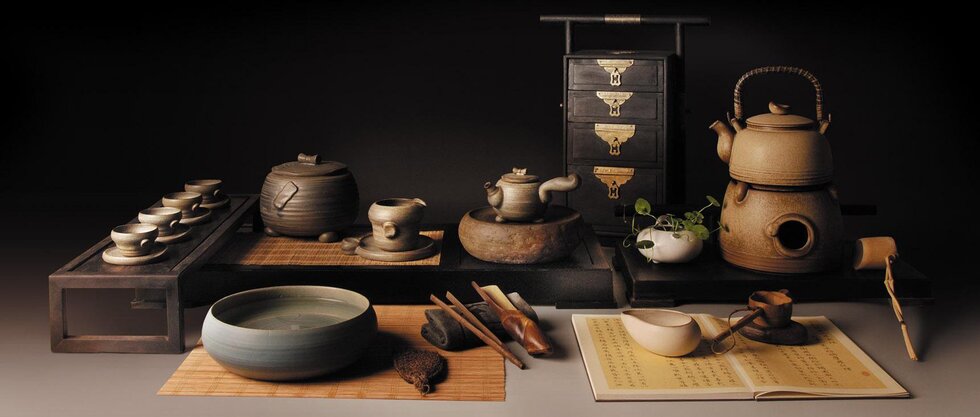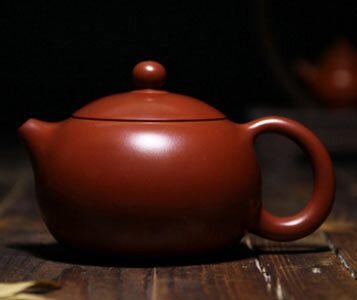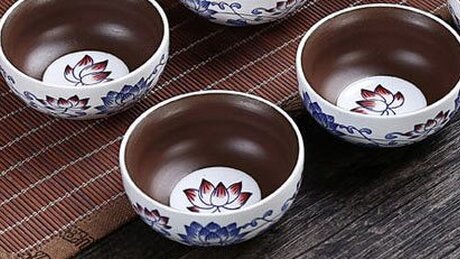If you happen to think that the amount of tea-ware used in tea brewing is overabundant, remind yourself that in the time of Tang dynasty, as «The Classic of Tea» narrates, the number of must-have articles required for tea preparation amounted to 24. To brew tea the traditional Chinese way — by steepings — you will only need a gaiwan or a teapot, a chahai and teacups. For brewing convenience I recommend to add another 3 articles: a chapan or a tea pool, chahe and a tea towel.
The principal choice you have to make prior to buying a tea-ware is whether you prefer brewing tea in a teapot or in gaiwan. Our choice begins from these two particular articles, as they are the main characters in the play attracting special attention and all other elements should be in tune with them. Their style, material, pattern, color affect the composition of the whole set. European mentality aims at already made tea-ware ensembles — to buy gaiwan, cha hai and cups of the same style. However this is but a treacherous path. Chinese tea aesthetics assumes step-by-step selection of individual articles. As a result your tea set should be concordant, well-balanced and attractive, but in no way unsavory. After buying a set of tea-ware in the uniform style one will need to blend them with additions, to tinge and to finish.
Gaiwan (盖碗) is absolutely unique piece of tea-ware. Originating from China, its authentic design appeared in 17-th century at the time of Manchu Qing dynasty. Manchus, who conquered China, had lost their heart to its advanced, refined and highly spiritual culture which assimilated them entirely. Many emperors of Qing dynasty became adepts of tea. In this period the tea business has been rapidly developing with the variety of tea-houses opening around the country and major part of its inhabitants drinking tea.
The name of «gaiwan» itself translates as «a cup with a lid». Initially gaiwan was used for individual tea drinking. Eventually it started to be used for sateeping tea and pouring it into cups.
Porcelain gaiwan is universally applicable for brewing of any tea, be it a green tea or pu’er. Therefore, in my opinion, it fits the best for introduction to the Chinese tea culture.
Teapot (cháhū, 茶壶) is also deemed to be invented by the Chinese. It appeared around 14-th century with the arising necessity to brew tea in a vessel instead of boiling it in a caldron. The teapot became a successor of already existing jars and stepwise through centuries acquired its current form.
Most well known in Chinese culture are Yixing teapots. They are produced of the special clay quarried around the city of Yixing. Its unusual mineral composition delivers the unique, almost magical qualities. And naturally each fan of Chinese tea sooner or later wishes to get at least one such teapots in own possession.
The only disadvantage of Yixing clay is its highly porous structure, which actively absorbs flavors, therefore is suitable for brewing of one tea type. The purchase of such item is rational only in case of irresistible necessity. Porcelain or enamel covered clay teapots will better serve as first brewing tea-ware. They enable to brew all types of tea in a single vessel.
Teacup, bowl (chábēi, 茶杯) — an item quite ordinary for us except for the unusual size of Chinese teacups. While your office cup capacity is 200-350ml, the Chinese teacup for traditional tea drinking contains from 20 to 50ml. Naturally, a beginner wants a bigger cup. Only very soon after several tea sessions owners of large cups notice that it becomes difficult for them to drink all the brewed tea as traditionally it undergoes around 10 consecutive steepings. When your teacup is at least 50ml you have to outdrink up to half a liter of tea, which may be quite a surfeit. When using minor cups in the tea session together with drinking your fill you relish the flavor of each steeping without repletion to the sense of discomfort.
The material the teacup is produced of makes no difference, so to say. However there are certain aspects to be observed. Some thinwalled or glass teacups may be hard to hold for people with hypersensitive skin. Yixing clay and tenmoku ceramic contain much iron and soften the water and many Chinese consider tea from such cups to be tastier. However it does not functionally affect the tea brewing itself.
Teacups are selected by the call of one’s heart and to one’s own cheek. If one-styled tea-ware on the table strikes a chord in your soul — buy a tea set. If you want to express your personality then buy something unconventional. Traditional, bright Chinese teacup on the shelf will capture the attention of your friends. Teacups with white glazing inside or made of glass allow the infusion to be clearly visible. Whether you attempt to get softer flavor — buy a cup of Yixing clay. This is all up to you. In the choice of the cup there can not be correct or incorrect decision. The only thing to be kept in mind is the capacity of cups to be adequate with the amount of tea brewed so it suffices everybody. But this is but pure mathematics.
Chahai (茶海, translates: «sea of tea») or the cup of fairness (gōngdàobēi, 公道杯) — an optional article not directly involved in tea brewing however the lack of it incurs inconveniences. After steeping the tea leaf in a gaiwan or a teapot the infusion is poured into the cup of fairness. The main function of this vessel becomes clear from its name. If the tea is poured directly from the teapot into guests’ cups the infusion in the first cup will be too weak and the most rich will it be in the last one. This is not fair. However, if the infusion is poured into chahai with the following distribution between teacups the tea in each of them will be alike.
Besides, chahai performs a number of other functions. It separates the infusion from the tealeaf and therefore ceases the brewing process. The brew in the teapot awaits next steeping and the tea without haste can be poured into teacups. When the chahai is empty one may enjoy the aroma still resting inside where it manifests itself in its full splendor. If chahai is made of glass one may enjoy the color of the infusion in it.
Chaban (chápán, 茶盘) — special board for tea sessions where the excess water drains. When preparing tea you rinse the tea-ware, pour off the remaining tea or may accidentally spill the water. Chapan is used to keep the tea-drinking place tidy. It has a built-in tray for water to be dumped upon conclusion of the tea drinking. Some boards are equipped with a hose instead of a tray. Such models are most popular in China.
Tea-boards are known from the ancient times, however the up-to-date model with the water drain has been invented just a couple decades ago.
Tea pool (cháchí, 茶池) — analog of chapan. If you discard chapan, you may use a tea pool — pour off all the excessive water in it during the tea session.
In recent decades China returns to old tea-drinking traditions. Cast iron kettles for water boiling become increasingly popular, modern tea sets more clearly feature ancient forms. Textile and woven mats grow larger, more elegant and exquisite. Therewith brewing of tea with tea pool is getting popular as well. Such tea sessions presumably will appear more exalted compared to brewing on chapan.
You do not necessarily need to use Chinese tea pool with the suffice of porcelain plates available. They will perfectly look on your table replacing the authentic tea-ware.
Chahe (茶荷, translates as «tea lotus») — a plate used for acquaintance with the appearance of a leaf and its aroma. Prior to tea session a distinct amount of tea is filled into chahe which is afterwards shifted to the gaiwan. The main convenience of using chahe is the ability to measure the required amount of tea in advance.
Tea towel (chájīn, 茶巾) or tea napkin (chábù, 茶布) — another optional but useful element of tea session. Chinese towel may be replaced by any «local» cloth. What is most important is that it does not scratch the surface of chapan. Tea towel is often used for wiping tea spilled on chapan. Hot tea-ware pieces are also placed upon it when passing around to guests: teapot for acquaintance with the aroma of steeped tealeaf; chahai to inhale the scent of the infusion. The napkin wipes the bottom of the teacup before passing it to the guest. Altogether this is another article worth buying to keep your tea session tidy.
As you may see completion of your first tea set is not such a complicated task as some articles may already be in your household. Naturally each person practicing Chinese tea brewing on a regular basis in time becomes overgrown with the number of tea articles of various utility. Except for purely functional there will inevitably appear some magic and atmospheric ones: tea deities for chapan, a brush for a teapot, incenses, vases etc. This path is endless.











